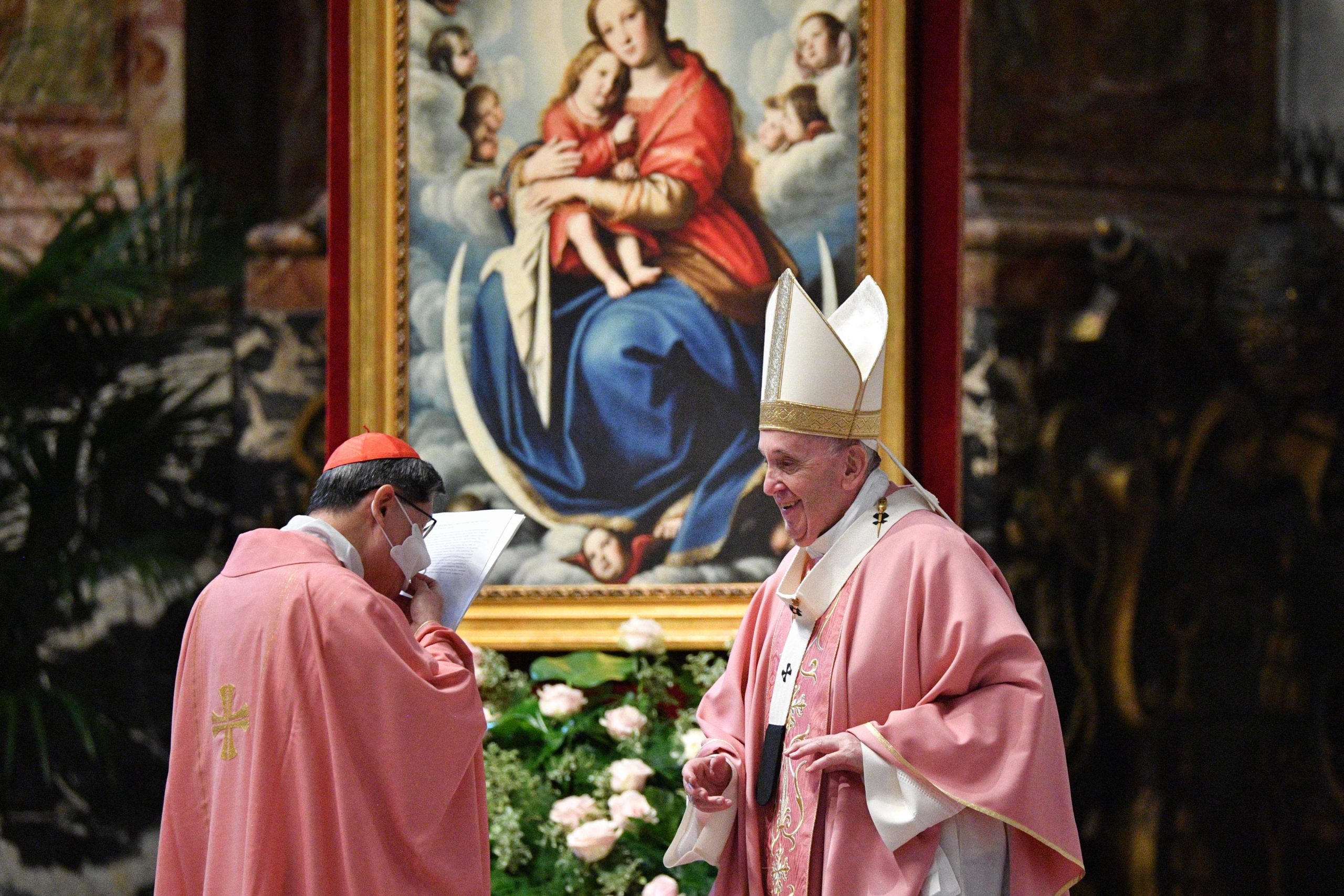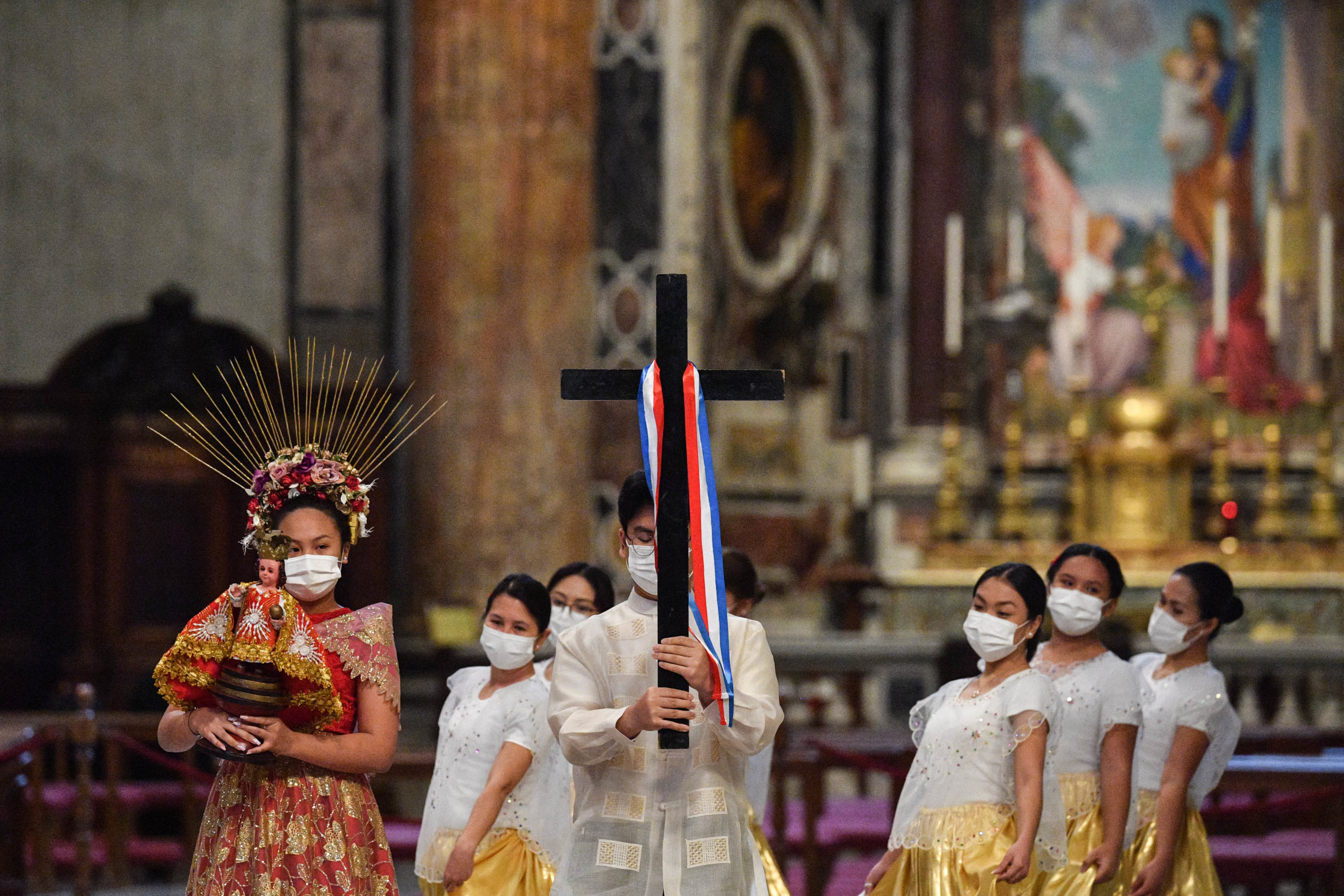Pope Francis hails Filipinos for ‘smuggling’ faith

GOD’S GIFT Filipino Cardinal Luis Antonio Tagle thanks Pope Francis and the Catholic Church for sharing the Christian faith with Filipinos during the Sunday Mass celebrated by the Pontiff marking 500 years of Christianity in the Philippines at St. Peter’s Basilica. —AFP
MANILA, Philippines — In a Mass led by Pope Francis at the Vatican on Sunday to mark the 500th year of Christianity in the Philippines, Filipino Cardinal Luis Antonio Tagle thanked him and the Catholic Church for sharing their faith, a gift that has helped Filipinos endure all hardships, including the COVID-19 pandemic.
“The coming of the Christian faith to our land is God’s gift. The fact that the Christian faith was received by the majority of our people who gave it a Filipino character is also a gift of God,” Tagle said during the Mass at St. Peter’s Basilica, which was streamed live worldwide.
According to Tagle, the Philippines now accounts for the third largest number of Catholics in the world as millions of Filipinos continue to express their faith amid the pandemic. There are more than 10 million Filipino migrants living in almost 100 countries.
God’s gift
In his message to the Pope, Tagle, the prefect of the Congregation for the Evangelization of Peoples, praised the Catholic Church for the gift of faith that has been “one of the sources of hope in facing poverty, economic inequality, political upheavals, typhoons, volcanic eruptions and even the current pandemic.”
He stressed, however, that the gift of faith must be shared with others. This was one of the responsibilities of the Catholic faithful in accordance with the 2021 Year of Missio Ad Gentes, or Mission to All Nations.
Article continues after this advertisement“The gift must continue being a gift. It must be shared. If it is kept for itself, it ceases to be a gift. By God’s mysterious design, the gift of faith we have received is now being shared by the millions of Christian Filipino migrants in different parts of the world,” Tagle said.
Article continues after this advertisementHe also thanked the Pope for serving as the Philippines’ “Lolo Kiko,” or grandfather, as the Pontiff expressed his gratitude to Filipinos for their enduring faith.
“Five hundred years have passed since the Christian message first arrived in the Philippines. You received the joy of the Gospel: the good news that God so loved us that he gave his Son for us. And this joy is evident in your people. We see it in your eyes, on your faces, in your songs and in your prayers. In the joy with which you bring your faith to other lands,” Pope Francis said in his homily.
“I have often said that here in Rome, Filipino women are ‘smugglers’ of faith because wherever they go to work, they sow the faith. It is part of your genes, a blessed ‘infectiousness’ that I urge you to preserve. Keep bringing the faith, the good news you received 500 years ago, to others,” he added.
The Pope also urged Filipinos to “persevere in the work of evangelization … The Christian proclamation that you have received needs constantly to be brought to others. The Gospel message of God’s closeness cries out to be expressed in love for our brothers and sisters.”
The Mass opened and ended with Cebuano songs, one of them a centuries-old hymn honoring the Santo Niño de Cebu.

FILIPINO FLAVOR Members of the Filipino community in Rome carry an image of Sto. Niño (Child Jesus) and a cross to the Pope’s Mass, which opened and ended with Cebuano songs, including a centuries-old hymn honoring the Sto. Niño de Cebu. —AFP
“Batobalani sa Gugma (Magnet of Love)” was sung at the beginning as the image of the Child Jesus was brought to the altar inside Saint Peter’s Basilica.
Cebuano songs
The Mass ended with the song “Maria, Rayna sa Pilipinas (Mary Queen of the Philippines)” in honor of the Blessed Virgin Mary.
“We are happy. It is an honor that the Vatican [used] the Cebuano songs. This is not just a celebration for Cebuanos but for the entire Philippines,” said Monsignor Joseph Tan, the spokesperson for the Archdiocese of Cebu, in an interview in Cebu City.
Fr. Ric Anthony Reyes, Basilica Minore del Santo Niño spokesperson, said that Batobalani sa Gugma was the oldest song honoring the Santo Niño.
The original and longer version of the song written in Cebuano can be found in the oldest Novena booklet that dates back to the late 1700s.
Santo Niño
A shorter and modern version was made in the 1980s, said Reyes, who added that the hymn showed how the Santo Niño has affected the lives of people through the centuries.
“It is a collective story of devotees, the miracles of the Holy Child, and the devotion to the Santo Niño,” he said.
“Of course, we are very happy and elated that it was used during the Papal Mass because we know that the Santo Niño has a very major role in the celebration of the 500 years of Christianity in the country,” Reyes said.
The Santo Niño de Cebu is considered the oldest religious image in the country. It was given by Portuguese explorer Ferdinand Magellan to Cebu’s Hara Humamay in 1521 as a baptismal gift.
Only around 100 people were allowed inside Saint Peter’s Basilica to maintain physical distancing.
The concelebrants were also limited to just 10, including Tagle and Angelo Cardinal De Donatis, the Pope’s Vicar for Rome.